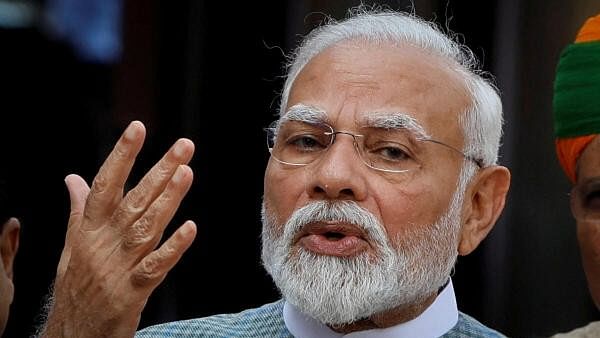
PM Narendra Modi
Credit: Reuters File Photo
Many believe that there is more than meets the eye in the relentlessly hyped 400 and 370 seat predictions for the National Democratic Alliance (NDA) and the Bharatiya Janata Party (BJP) respectively.
The former number was conjured out of thin air by Prime Minister Narendra Modi and the latter by Home Minister Amit Shah. All that remained was for the compliant sections of the media and ‘psephologists’ to run with them — and they did. But after the first phase of polling, when the low turnout spooked the ruling party, the wheels started to come off.
As anxiety gripped the BJP, Modi launched himself into an unabashed and unprecedented attack on the Muslim community, failing to disguise it as an attack on the Congress. On April 21, at Banswara, Rajasthan, Modi said that the Congress manifesto had pledged to carry out a survey to attach property and redistribute it to ‘those who had more children’ and ‘infiltrators’. He also said Hindu women’s mangalsutras would be snatched. The insulting reference to Muslims was more shameful than the bald lie. For those who care, the Congress manifesto talks about the reduction of inequalities.
A few days later, newspapers reported that Indian Overseas Congress chairman Sam Pitroda said that the United States inheritance tax was an ‘interesting law’ and should be a part of the debate on the redistribution of wealth.
The BJP jumped in, misrepresenting the comments, and ignoring the fact that during the tenure of the earlier BJP-led National Democratic Alliance (NDA) government, then Union Finance Minister Arun Jaitley proposed a similar idea in 2017.
Modi tried to kill an important discussion on economic inequality. But, it has been flagged by the authors of a recent paper, who have concluded that India has become one of the most economically unequal countries in the world, with levels of inequality now higher than those in the colonial period. Though inequality has grown phenomenally in this century, the last decade has seen a big acceleration.
In ‘Income and Wealth Inequality in India, 1922-2023: The Billionaire Raj’, Nikhil Kumar Bharti, Lucas Chancel, Thomas Piketty, and Anmol Somanchi (of the World Inequality Lab) say, ‘Between 2014-15 and 2022-23, the rise of top-end inequality has been particularly pronounced in terms of wealth concentration. By 2022-23, top 1 per cent income and wealth shares (22.6 per cent and 40.1 per cent) are at their highest historical levels and India’s top 1 per cent income share is among the very highest in the world.’
The paper also says that in line with earlier work, there is suggestive evidence that India’s taxation system might be regressive ‘when viewed from the lens of net wealth’. Before investigating this insight, we should note another statement: ‘We emphasize that the quality of economic data in India is notably poor and has seen a decline recently. It is therefore likely that our results represent a lower bound to actual inequality levels. We call for improved access to official data and greater transparency to enhance the study of inequality and enable evidence-based public debates.’ Many observers in India have noted this regime’s tendency to systematically suppress or fudge inconvenient data, and put on ice established official surveys — for instance, on employment.
In any case, what Bharti, et al, are saying is that there has been an increasing disparity of both wealth and income — the former being the total sum of assets and the latter the sum of all earnings. The paper says that the richest 1 per cent in the country enjoys 22.6 per cent of total income and 40.1 per cent of wealth. These figures are mirrored by the numbers on the growth of billionaires — from one in 1991 to 162 in 2022. Their share of total net wealth ‘boomed from under 1 per cent in 1991 to a whopping 25 per cent in 2022’. The number of billionaires has increased to 200 in 2024. Their combined wealth is $954 billion, up 41 per cent from 2023.
The authors of the inequality study say that a super tax of 2 per cent on the 162 wealthiest Indians would earn revenues equal to 0.5 per cent of national income and enable indispensable public investment in health, education, and nutrition. In many countries, super-rich individuals have demanded such a tax, but we haven’t heard from the Indian billionaires yet.
To be sure, the Modi regime, intent on benefiting cronies and keeping a beady eye on the party coffers, is not going to think of redistributing entitlements to the poorest. It is thus that the prime minister does his best to deflect attention from material issues.
(Suhit K Sen is author of ‘The Paradox of Populism: The Indira Gandhi Years, 1966-1977’.)
Disclaimer: The views expressed above are the author's own. They do not necessarily reflect the views of DH.